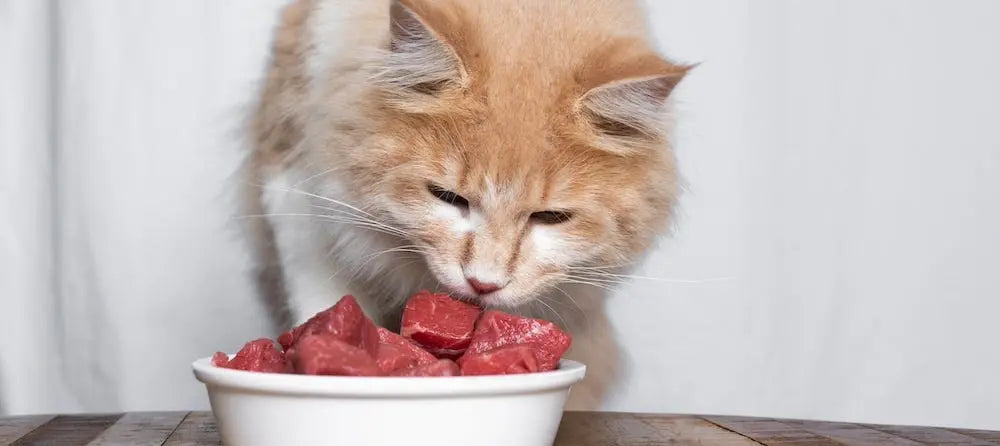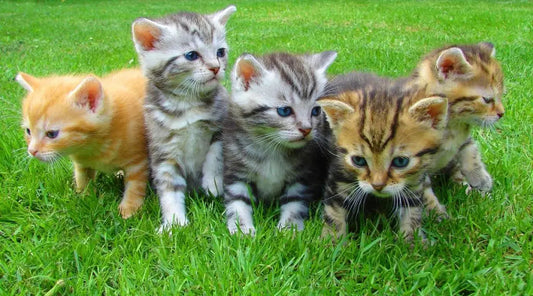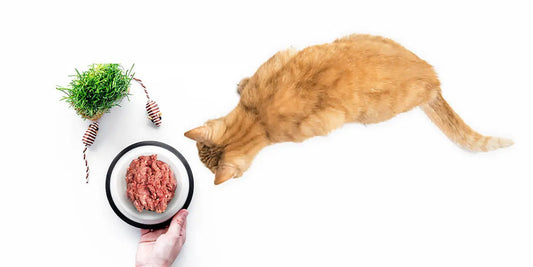
What Type of Cat Food is Best?
Cats need proper nourishment to feel like their naturally curious and lovable selves. But just like us, finding the right diet for your feline is easier said than done. With so many types of cat food available, all claiming to be the next best thing, it’s more than a little overwhelming to pick one.
That’s where Darwin’s comes in.
Our goal is simple: to provide you with reliable, science-backed information so you can confidently choose the most nutritious food for your cat. Learn about the different types of cat food and their benefits for happy and healthy meal times.
Types of Cat Food
At Darwin’s, we believe in feeding cats the way nature intended—with fresh, raw, and minimally processed food that supports their well-being. Backed by two decades of research, hands-on experience, and the expertise of our in-house care team, we’ve learned a thing or two about what cats need.
So, what’s the deal with all these different types of cat food? We’re glad you asked.
Fresh Cooked Cat Food
For the chefs out there, fresh cooked cat food may sound appealing. This is food that you prepare yourself in your own kitchen.
Before throwing on your apron, make sure you’re following veterinarian-approved recipes and confirming that they meet your cat’s nutrient requirements. You’ll also want to take extra precautions when it comes to food safety to avoid any mishaps.
Sound up your cat’s alley? Here’s the real allure. Feeding cats fresh cooked food means:
-
You’ll have complete control over ingredients.
-
You can avoid ingredients your cat doesn’t tolerate.
-
You can ditch preservatives and fillers found in other types of cat food.
If you’re still figuring out what you’re cooking yourself tonight, fear not—you have several other (pre-prepared) cat food options available.
Fresh Raw Cat Food
You’ve probably heard of the raw cat food diet—maybe your brother or neighbor swears by it for their feline friends. But, what is it, exactly?
The raw food diet emerged from peering into cats’ ancestral habits. Cats evolved as obligate carnivores, or meat eaters. The idea is that they should continue eating their ancestral diet for optimum health.
But don’t just take our word for it—science backs us up.
Unlike humans or dogs, cats have a single enzyme for digesting carbohydrates and a short digestive tract, leaving them ill-equipped to process foods other than raw meat. Fresh cat food provides felines with all the nutrients they need—and none of the ones they can’t stomach.
Freeze-Dried Raw Cat Food
The freeze-dried raw cat food diet offers all the same benefits as fresh raw food—minus the moisture.
You’ve likely heard of freeze-drying pet food, but what does the process actually look like?
First, the food is frozen rapidly; then a mild heat is introduced. The ice formed during the flash freeze turns into water vapor that is then extracted using a vacuum pump, removing up to 90% of the water. The ice never turns to liquid, leaving the molecules in the food unchanged from the process.
In other words, still raw, and still in line with cats’ ancestral dietary needs. Just remember to rehydrate freeze-dried foods to ensure your cat maintains proper hydration levels.
Wet Cat Food
A true classic, wet food has a similar texture to raw meat, meaning it’s extremely moist and easy for cats to eat. However, be mindful of the ingredients in canned wet food. Avoid any products containing things like grains, fillers, artificial colors, or preservatives.
Kibble Cat Food
Another common choice, kibble food consists of processed, hard, dry pebbles that you measure with a scoop. Just as with canned food, it’s extremely important to ensure it's of the utmost quality. Avoid the same ingredients listed above.
How to Choose the Best Food for Your Cat
When deciding which diet and the best protein for cats, you must keep a few important factors in mind.
Consider Your Cat's Age and Health
Your cat goes through various life stages, each coming with a different set of nutritional needs. Pet foods recognize and cater to these key stages:
-
Gestation/lactation
-
Growth
-
Maintenance
-
All life stages
Other foods are developed specifically to support cats with certain health conditions, like kidney disease, for example.
Working in consultation with your vet, be sure to read the labels on your cat’s food, ensuring that their health and dietary requirements are being met.
Check Ingredient Quality
Just as your body is a temple, so is your cat’s. Always read labels carefully and make sure you understand the ingredients listed.
If preparing your own food, buy fresh, organic ingredients and handle them with care. When choosing pre-prepared options, select those without fillers, chemical preservatives, hormones, or grains—like ours.
Common Cat Food Ingredients to Avoid
Not all cat foods are created equal. Some use misleading marketing or low-quality ingredients that can harm your cat’s health in the long run. Watch out for:
-
Meat by-products instead of named meat sources (e.g., "chicken" or "beef")
-
Added sugars or sweeteners
-
Excessive carbohydrate fillers like corn, wheat, or soy
-
Artificial preservatives like BHA, BHT, or ethoxyquin
If a food doesn’t clearly list its ingredients—or you wouldn’t eat them yourself—it’s probably not good enough for your cat either.
How to Transition Your Cat to a New Diet
Cats can be creatures of habit, especially when it comes to food. Switching diets too quickly can cause digestive upset or outright refusal to eat. A gradual transition helps your cat’s system adjust to the new food while maintaining mealtime consistency.
Here’s a simple transition timeline:
-
Days 1–3: 25% new food, 75% old food
-
Days 4–6: 50% new food, 50% old food
-
Days 7–9: 75% new food, 25% old food
-
Day 10+: 100% new food
Every cat is different—some adapt quickly, others take their time. Pay close attention to their appetite, energy levels, and litter box habits during the switch.
What If My Cat Is a Picky Eater?
Some cats turn their nose up at anything unfamiliar. If you’re trying to improve your cat’s diet and they’re not on board, try these tips:
-
Warm the food slightly to release aromas and mimic fresh prey
-
Add a topper like bone broth or freeze-dried raw bits to entice them
-
Stick to a schedule and remove uneaten food after 20–30 minutes
-
Avoid too many treats throughout the day, which can reduce appetite for real meals
Consistency and patience are key—your cat may just need time to adjust to the new routine.
Meet Your Cat’s Every Need with Darwin’s
Understanding your cat’s dietary needs is an ongoing process that takes patience, love, and care. No pet parent is perfect, but we’re here to help you come close.
Over the past two decades, Darwin’s has served over 100 million fresh, raw meals to pets. Each meal is crafted with human-quality ingredients inspired by nature and informed by science. Our dedicated team is committed to giving your pet a longer, healthier life—just like you.
And with our convenient pet food delivery service, you never have to worry about running out of meals that support your cat’s well-being.
Feed your cat the way nature intended by starting their ancestral diet journey today. Take the next steps by completing our quiz and consulting with our in-house experts to find the ideal meal options for your furry feline.
Sources:
- AAFCO. How to Understand a Dog or Cat Food Label. https://www.aafco.org/consumers/understanding-pet-food/reading-labels/
- Darwin’s Natural Pet Products. Why Raw Cat Food? https://www.darwinspet.com/why-raw/raw-cat-food.html
- Hillcrest Pet Hospital. Thinking of Making Your Cat's Food? Read This First. https://www.hillcrestpethospital.com/services/cats/blog/thinking-making-your-cats-food-read-first
- University of Minnesota Extension. Freeze-drying Food. https://extension.umn.edu/preserving-and-preparing/freeze-drying-food
- The Vets. 5 Cat Food Ingredients to Look For & Ones to Avoid. https://thevets.com/resources/pet-nutrition/cat-food-ingredients/
- The Vets. Cat Food Ingredients: What to Look for and Avoid. https://thevets.com/resources/pet-nutrition/cat-food-ingredients/
- PetMD. Changing Your Cat's Food: How to Do It Safely. https://www.petmd.com/cat/nutrition/changing-cats-food-how-to
- PetMD. 6 Reasons Why Your Cat Is Not Eating and What To Do. https://www.petmd.com/cat/nutrition/cat-not-eating-what-to-do


